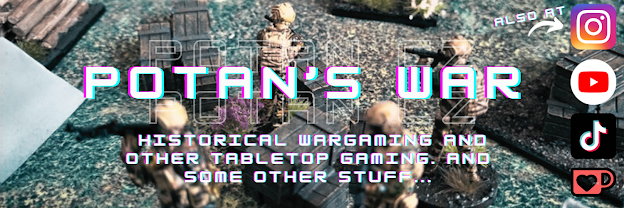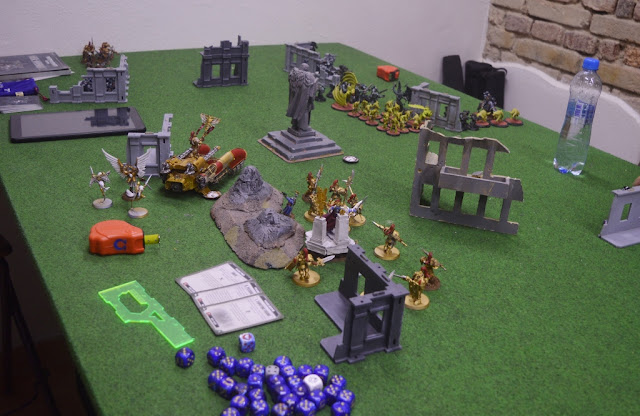In previous articles, we've looked at two ways to divide wargaming games: wargaming and its scales: from skirmishes to armies, and wargaming and its scales: when millimeters define miniatures. If you're finally ready to get down to the actual gameplay, the following lines will show you what you might need to do so.
Universal tools
There are things that are needed for virtually all wargaming. The best part is that you probably have some of them at home and don't even know it. What almost all games need are dice and a tape measure.
The most commonly used dice are the classic six-sided dice like in "Ludo", in our hobby slang called D6. D for Dice, meaning a die and a number indicating the number of its sides. Recently, more and more games working with D8 or directly D10 are also appearing due to the greater variance of rolls and modifiers.
The tape measure for the vast majority of games must have inches, as almost all of them work with imperial measure and not in the continental metric system. This is most likely due to the fact that the main boom in wargaming came in the United States and Great Britain back when the latter was still using the imperial system of measurements. Anyway, any DIY shop can help you with a tape measure that can do inches and not just centimetres.
The tape measure is also a way to get to know current and former Warhammer players - they use Games Workshop's iconic tape measure with the Imperial Eagle from Warhammer 40,000. Additionally, having a few tokens on hand to count all sorts of things like lives won't go amiss. These are just things that won't go to waste, even if you opt for Warhammer and/or Black Seas from Age of Sails.
Choice of game or rules
When you want to play something, it's important to think about what you want to play. You know from the articles on scaling that we have different sized games, both in terms of the scope of the battlefield and the size of the miniatures. In this day and age of the internet, it's not a problem to google the topic or era you're after and you'll quickly learn about the existence of at least some select rules.
Any obscure thing you can think of to play with miniatures and dice rolls has probably been thought of by someone before you, and there will be rules and a host of models for it. For example, there's even a joke about Napoleonic wargaming that there are more different rules than there were battles during the war...
In addition to rules in the sense of "game systems" come rules as "books" - that is, literally physical books, nowadays often in digital PDF format, which you can keep on your mobile or tablet. Different games have different "demands" on the size of the library in this respect as well. There are those where you just buy the basic rules, which already contain everything to play and army sheets for each faction.
But so are the games that make you buy the base rules, the army rulebook, the campaign rulebook, the expansion for X, the expansion for XY, and every five years switch editions and make you buy new base rules, new army rules, and throw away the already outdated expansions. If you decide to start playing Warhammer 40,000, for example, you have to account for this constant "book spinning". On the other hand, with WH40K in particular, this will be one of the smaller expenses.
Once you have the rules selected, you may well have to buy other, not so universal little things specific to the game. These might be objective cards for Warhammer 40K, activation dice for Bolt Action, or ability dice for Saga. Sometimes these are things that just make you happy and with a bit of diligence you can replace them with your own efforts (but you just want nicely designed cards instead of labeled paper), but other times you really need components that are key to the game.
Models
Once you know what you want to play and have the necessary tools, you still have to choose what to play with. Here you just need to choose the scale that best fits your chosen rules and you can go shopping. The scale you choose will also determine how much money your bank account will be drained of.
This is where the slight advantage of historical wargaming over specific games with specific model lines comes in. A marine from Warhammer 40K will always just be a "hemr marine" and can be played with "just" Warhammer and maybe a few modular sci-fi systems that don't care if you have Adeptus Astartes or Master Chief from Halo on the table. And when you get tired of Warhammer (whether through regular edition changes, metagame changes, army rules, or FAQs), you're just out of luck and have three options.
Either you let the hobby sleep until the next rule change, suck it up, and keep playing what you're not enjoying so much, hoping that time will fix it again, or you try another sci-fi game and hope that your Warhammer models will fit in visually. However, when you get tired of some of the historical rules, either by changing editions or just getting "old", there's nothing easier than to try some different ones. The WWII machine gun squad is the model machine gun squad for any WWII game, though each may take a slightly different approach to the rules.
Another alternative route has become more and more prevalent in recent years, and that is 3D printing. Files exist (as do rules) for virtually anything you can think of. Fantasy, sci-fi, historical models of all eras, even "pirated" versions of Warhammer models. If it exists somewhere, it probably has a printable STL file as well.
The Opposing Player
Everything we have imagined so far is easily obtainable with money. In the case of the opponent, it's worse. Unless you choose to play a game containing a single player mode. Especially in recent years, due to covid restrictions, a lot of these have sprung up, including expansions that graft solo mode onto originally multiplayer games as well.
And in case you don't have any players of your dream game nearby, there's also the option of getting two armies - one for you and one for a friend who plays, for example, board games or computer strategy. Just show him some nice pieces and promise zero investment and maybe he'll catch on.
Here, of course, it depends on what he wants to play. If it's a small skirmish from WWII, you can easily get into with just 40 USD for a platoon of soldiers and a tank. If you want to start with, say, Warhammer 40K, that same amount won't buy a single box of basic infantry...
A place to play
Once you have the rules, dice, models and opponents, all that's left is to find a place to play! If you're from a bigger city, we've got great news for you. You might not have far to go to a wargaming room where you can come and play without having to worry about a big table, game mat and terrain.
And if you don't have a game room nearby, then you have no choice but to set up your own private mini-game room at home. The advantage is that you can tailor it to your gaming needs, buy the terrain you want to play on, you're not bound by what the game store has in its repertoire, and you're not worried about things like opening hours.
The downside, of course, is that it's more money and time invested in the hobby. And you still have to have space at home for something like this, which especially for apartment dwellers can be a real problem.
Nowadays, you don't even need to be creative and resourceful in any way, as you can buy a lot of terrain from a plethora of companies. Or, if you have a 3D printer at home or within easy reach, you can print them as well as the figures. So it is no longer the case that "home play" only takes place on a green tablecloth where books simulate hills and pots buildings. Once you play with real terrain, books just aren't enough anymore. And of course, the biggest advantage of home play is the convenience, the warmth of home, and the time saved from trudging halfway across town and beyond to a real hobby store.
Also, if you find this article helpful, you can buy something from Warlord store with my affiliate link or just buy me coffee. :)
Originally published in Czech on the ZeStolu portal. All images taken from my Hobby Instagram page #Potan_CZ.







Comments
Post a Comment